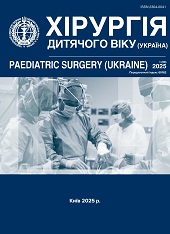Advantages of using modern minimally invasive technologies in acute surgical pathology of the abdominal cavity
DOI:
https://doi.org/10.15574/PS.2025.1(86).105109Keywords:
minimally invasive surgery, endoscopy, laparoscopy, robotic surgeryAbstract
Minimally invasive technologies are gaining popularity in Ukraine due to their high treatment efficiency, low number of complications, and high cost-effectiveness. A significant problem in modern Ukrainian medicine is the use of laparoscopic equipment of different generations, which can lead to diagnostic and medical errors and prevent the expected results.
Aim - to analyze the prevalence of minimally invasive treatment methods in Ukrainian hospitals; to study, divide minimally invasive equipment into groups depending on its time of origin and capabilities, assess the advantages and disadvantages of each group and the possibility of using minimally invasive equipment, taking into account the technical generation in Ukrainian hospitals.
A literature review was conducted using Medline, PubMed and scientific literature. We analyzed the development of minimally invasive and robotic surgery and articles reporting data on their application.
Conclusions. The growing popularity of minimally invasive technologies and robotic surgery in Ukraine leads to the emergence of new equipment in Ukrainian hospitals. There is a problem of the emergence of various equipment in the absence of standardization of indications and contraindications for surgical interventions depending on the equipment of a particular hospital in Ukraine.
No conflict of interest was declared by the authors.
References
Boni L, David G, Mangano A et al. (2015). Clinical applications of indocyanine green (ICG) enhanced fluorescence in laparoscopic surgery. Surg Endosc. 29: 2046-2055. https://doi.org/10.1007/s00464-014-3895-x; PMid:25303914 PMCid:PMC4471386
Dvorakevich AO, Guraevskyi AA, Stasyshyn AR, Guraevskyi DA, Shevchuk DV, Kalinchuk OO. (2022). The first experience of using robot-assisted surgery in childhood in Ukraine. Pediatric surgery (Ukraine). 4(77): 91-95. https://doi.org/10.15574/PS.2022.77.91
Guanà R, Ferrero L, Garofalo S, Cerrina A, Cussa D et al. (2017, Jul-Aug). Skills Comparison in Pediatric Residents Using a 2-Dimensional versus a 3-Dimensional High-Definition Camera in a Pediatric Laparoscopic Simulator. J Surg Educ. 74(4): 644-649. Epub 2016 Dec 27. https://doi.org/10.1016/j.jsurg.2016.12.002; PMid:28039097
Krebs T, Schnorr I, Heye P, Häcker F-M. (2022). Robotically Assisted Surgery in Children - A Perspective. Children. 9(6): 839. https://doi.org/10.3390/children9060839; PMid:35740776 PMCid:PMC9221697
Leon P, Rivellini R, Giudici F, Sciuto A, Pirozzi F, Corcione F. (2017, Apr). 3D Vision Provides Shorter Operative Time and More Accurate Intraoperative Surgical Performance in Laparoscopic Hiatal Hernia Repair Compared With 2D Vision: A Case-Control Analysis. Surgical Innovation. 24(2): 155-161. https://doi.org/10.1177/1553350616687434; PMid:28118788
Nezhat F. (2003, Jan-Mar). Triumphs and controversies in laparoscopy: the past, the present, and the future. Journal of the Society of Laparoscopic and Robotic Surgeons. 7(1): 1-5.
Rusak PS. (2023) Analiz khirurhichnoi dopomohy dytiachomu naselenniu oblasti za 2022 rik. URL: https://docs.google.com/viewer?url=http%3A%2F%2Fwww.asz.org.ua%2Fimages%2Fstories%2Fmaterials%2Fanaliz_hirurgiy_2022%2Fanalysis_of_surgical_care_for_the_childrens_population_of_the_region_for_2022.pdf.
Rybalchenko VF. (2013). Analiz roboty dytiachoi khirurhichnoi sluzhby Ukrainy u 2012 rotsi. Khirurhiia dytiachoho viku. 3: 24-33. URL: http://nbuv.gov.ua/UJRN/Khdv_2013_3_8.
Van Haasteren G, Levine S, Hayes W. (2009, Dec). Pediatric robotic surgery: early assessment. Pediatrics. 124(6): 1642-1649. Epub 2009 Nov 16. https://doi.org/10.1542/peds.2008-3822; PMid:19917586
Verdaasdonk EGG, Stassen LPS, van der Elst M et al. (2007). Problems with technical equipment during laparoscopic surgery. Surg Endosc. 21: 275-279. https://doi.org/10.1007/s00464-006-0019-2; PMid:17122973
Zaporozhan VN, Grubnik VV, Boner Yap. (2023). Endoskopichna і robotizovana hirurgiya. Navch. posybnik. 2 vidannya. Odesa: VSV Medytcina: 46.
Zaporozhan VN, Grubnik VV, Saenko VF, Nychytailo ME. (1999) Videoendoscopicheskie operacii v hirurgii i ginekologii. Monograph. Kyiv: 23.
Downloads
Published
Issue
Section
License
Copyright (c) 2025 Paediatric Surgery (Ukraine)

This work is licensed under a Creative Commons Attribution-NonCommercial 4.0 International License.
The policy of the Journal “PAEDIATRIC SURGERY. UKRAINE” is compatible with the vast majority of funders' of open access and self-archiving policies. The journal provides immediate open access route being convinced that everyone – not only scientists - can benefit from research results, and publishes articles exclusively under open access distribution, with a Creative Commons Attribution-Noncommercial 4.0 international license(СС BY-NC).
Authors transfer the copyright to the Journal “PAEDIATRIC SURGERY.UKRAINE” when the manuscript is accepted for publication. Authors declare that this manuscript has not been published nor is under simultaneous consideration for publication elsewhere. After publication, the articles become freely available on-line to the public.
Readers have the right to use, distribute, and reproduce articles in any medium, provided the articles and the journal are properly cited.
The use of published materials for commercial purposes is strongly prohibited.

